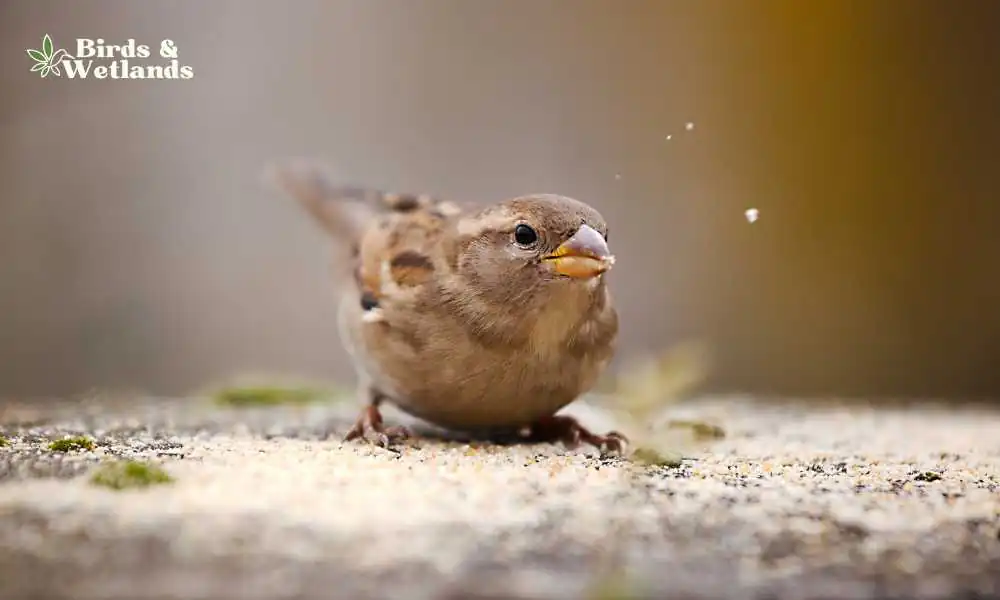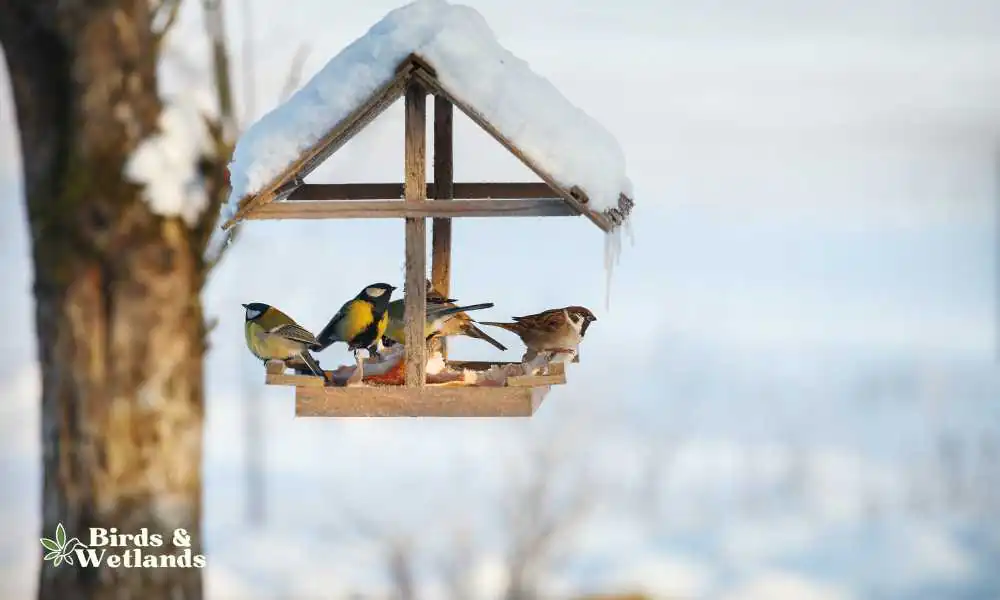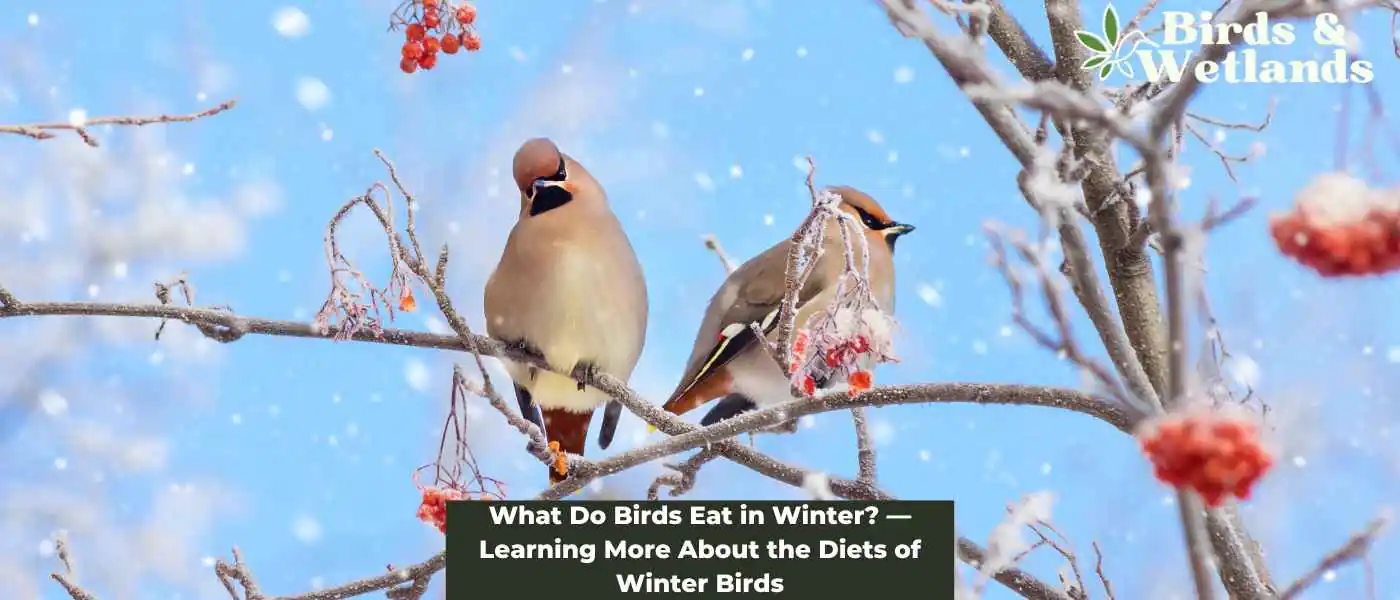Winter brings poor weather conditions that can significantly affect the food sources of North American birds. As temperatures drop and snow covers the ground, many of the birds’ natural food sources, such as seeds, berries, and insects, become scarce or even disappear completely. This can strain the birds’ survival, especially during the long, harsh winter months.
When food is scarce, birds have to get creative in finding sustenance. They may turn to alternate food sources such as suet, mealworms, cracked corn, fruits or birdseed.
Humans can help by providing bird feeders filled with these foods or setting up birdhouses for nesting. These small actions can make a big difference for birds during the winter, providing a much-needed food source and shelter. Not only will you be helping the birds, but you’ll also get to observe and enjoy their beauty up close.
Key Takeaways on What Birds Eat
Do birds need food in the winter?
When it comes to feeding birds, the winter season can be a crucial time for birds looking for an extra energy boost. While winter bird feeding may not be necessary, it can be extremely beneficial for birds who have trouble finding food during this season.
During cold temperatures, birds need more energy than usual to keep themselves warm and survive in frigid environments. When natural food sources become scarce due to the harshness of winter, birds will turn to bird feeders for sustenance.
Long-distance migrants often rely on stopover sites with reliable food sources along their migration routes to find enough energy for their long journey. Birdfeeders are great places for these migrants to rest and refuel, and providing them with added nutrition can significantly increase their chances of making it safely through their travels.
What do wild birds eat naturally in winter?

In the winter months, the diet of wild birds can vary depending on the species and their natural habitat. However, there are some common food sources that many birds rely on during this time.
Ground-feeding birds, such as finches, brown creepers and sparrows, will often feed on the seeds of trees and shrubs and weed seeds found in fields and along roadsides. Some species of winter birds eat insects and spiders, which can be a valuable source of protein during the winter when natural seed sources are limited.
Birds that feed on fruit, such as robins and cedar waxwings, will look for the fruit of evergreen trees and shrubs and berries that persist on plants through the winter. They may also eat tree buds and insects.
Waterfowl, such as ducks and geese, feed on aquatic plants and small invertebrates in rivers, lakes, and ponds. They may also consume grain and waste grain in agricultural fields.
Insect-eating birds, such as winter finches, bluebirds, American robins, blue jays, woodpeckers and other birds, may have more difficulty finding dormant insects and small animals in the winter, as flying insects are not as abundant.
Other game birds may feed on tree sap and store cache food and hidden insects in tree bark crevices. If you want to help these birds out, you can leave leaf litter in your garden.
How do winter backyard birds survive in the winter?

Birds are well-adapted to survive harsh winter weather, thanks to several physical and behavioral strategies.
Feathers provide birds with the insulation they need to stay warm in cold temperatures. Insulation works by trapping air pockets around the bird’s body, which acts like a downy blanket. This air is warmed by the bird’s body heat, creating an insulating layer of warmth next to its skin.
In addition to insulation, feathers also help regulate the moisture on a bird’s body. As their environment changes from cold to hot and back again, birds need their feathers to hold just the right amount of water to remain healthy and comfortable.
Migration plays an important role in helping birds survive cold winters too. Birds migrate shorter distances or not at all if they can find abundant food sources and shelter where they live year-round. But migratory birds fly south towards warmer climates, searching for food sources that aren’t available closer to home during those long winter months.
By storing fat reserves before migrating or hunkering down for winter, maintaining clean and dry feathers, and protecting themselves from frigid temperatures through migration or other adaptive behaviors, birds can brave even the most bitter winter conditions without succumbing to hypothermia or starvation.
Can you feed birds bread in the winter?
Bread may not be the most nutritious food for birds, but it can be an important energy source for birds during the winter when food is scarce. Feeding bread to birds helps them survive the cold winter months.
Birds can find different food types throughout the year, such as insects, dried fruit, seeds, and berries. However, these become increasingly difficult for birds to find during extreme weather, such as harsh winters.
Bread provides an additional source of nutrition for birds during this time that allows them to maintain their energy level until spring arrives and more food sources are available.
Keep in mind that many animals including birds have varied winter diets and they can’t survive on bread alone. They need adequate food sources to stay healthy and warm.
When to stop feeding birds in the winter?
As the cold winter months start arriving, many people are curious about when to stop feeding birds. While there is no exact timeline for when bird feeding should stop, most birders recommend ending by mid-March so that birds can prepare for their transition from short-term food sources to native insect and plant growth. This also allows them to shift their focus onto nest-building activities and breeding preparations.
Stopping bird feeding in the winter helps ensure healthier birds in the spring, as they have time and energy to find different food sources rather than relying only on those provided by humans.
What to feed birds in winter?
Backyard birding is still a rewarding experience, especially during the coldest winter months. If you want to help your local feathered friends survive winter, here are foods to feed backyard birds:
Black oil sunflower seeds, white proso millet and nyjer thistle seed mixes are among some of the best choices for a tube feeder in winter. Black oil sunflower seed contains beneficial nutrients like calcium, phosphorus, potassium, and vitamin E, while millet and nyjer thistle provide energy-rich calories. Most birds will eat them but they are favorites of pine siskins.
If you want to attract seed-eating birds, make sure there’s enough seeds in your tube feeders.
Nuts are some of the best foods for birds as they are high in energy, protein and essential vitamins and minerals for hungry birds. Whole nuts can be very popular with species such as jays and woodpeckers, but crushed nuts can cause a mess for small birds like robins and finches.
Different birds eat peanuts and hickory nuts. You can put them in a bird table and is an effective way of attracting birds. You can also mix them with baked crushed egg shells and dried mealworms.
Suet is bird food made up of raw beef fat, lamb or mutton and other ingredients such as oats, nuts, and berries. It is a high-energy food that is often served to birds during the year’s colder months. It provides winter birds the energy they need to stay warm and active.
You can combine suet with winter foods and other homemade bird treats and put it in your bird feeder or suet feeder to attract birds such as house finches, northern cardinals and other bird species.

